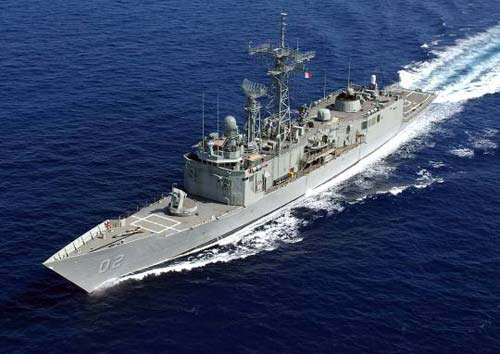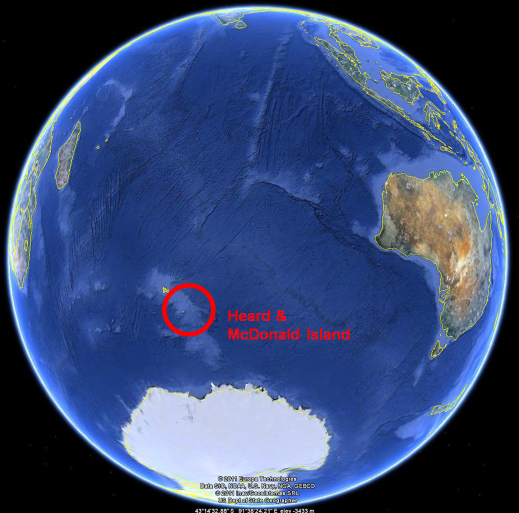This case study involves two related proceedings in the Federal Court of Australia and the International Tribunal for the Law of the Sea (ITLOS).
Both cases concerned the arrest of the Russian-flagged longline fishing vessel, Volga, which was apprehended by the Australian Navy for illegally fishing for Patagonian Toothfish in the Australian Fishing Zone (AFZ) adjacent to Heard and McDonald Islands, remote and uninhabited islands 4,000 km southwest of Perth.
The Volga was the second of two Russian-flagged vessels arrested by the Australian frigate HMAS Canberra within 24 hours of each other on 7 and 8 February 2002 (the other vessel was the Lena).
The Volga was arrested by Australian naval personnel who fast-roped from a helicopter launched from HMAS Canberra. The arrest occurred 0.5 nautical miles (900m) outside of the AFZ and exclusive economic zone (EEZ) just after the vessel exited the AFZ and EEZ.
Footage of the arrest of the Volga is shown below (this is raw footage and the sound quality is poor in parts). It begins from a helicopter flying over the Volga during the initial interception. It then cuts to scenes onboard the HMAS Canberra as the boarding party prepares to leave, then shows them boarding and inspecting the Volga. The film ends with the Volga and Lena entering the Port of Freemantle after their arrest. Thanks to the Royal Australian Navy for providing this footage.
When the Volga was boarded, its captain claimed that they had not been fishing in Australian waters but the evidence presented at the trial showed that this claim was false. In a subsequent decision by the Federal Court of Australia, French J (who later became Chief Justice of the High Court of Australia) described the evidence of recent fishing activity given by an Australian Fisheries Officer who boarded the vessel shortly after it was arrested by naval personnel:
[56] Mr Ferris conducted a search of the vessel. There were 120 tonnes of Patagonian Toothfish on board the Volga at the time. As he carried out the search he noted a large conveyor belt running from the fish factory working space located forward of the bridge to the stern of the vessel. It was wet and littered with damp small fish scales. In the stern area he found fresh wet fish gut and more damp fish scales. There was a number of fishhooks lying on the deck around the area of the conveyor belt. He found a small fish that looked like a Scaly Mackerel lying on the deck which was soft and pliable to touch. This part of the vessel was the long line setting space. There was a number of wooden segmented areas fenced off containing a large number of concrete blocks with a snap line attached to each block. On top of one of those piles of concrete blocks was a very large fishing net containing a large quantity of foam sponges. When Mr Ferris squeezed some of the sponges they oozed with water. There were also several racks of shelving containing brown plastic trays used for preparing small sections of long lines and holding baited hooks ready for setting. There was no prepared baited long line in the containers but they were wet and all the ones he checked at the time contained a large quantity of small fish scales.
[57] Mr Ferris then inspected the fish factory area which he described as damp and untidy. There were brown plastic trays scattered all over the working benches. There were numerous plastic bags containing a large quantity of fish hooks attached to a length of monofilament fishing line lying on top of the working benches. Mr Ferris searched for evidence of fresh product and eventually found two Patagonian Toothfish under a wire cage. One still had a hook in its mouth attached to a piece of fishing line. Both were still soft and pliable. He opened the gills on one fish and blood oozed out. The gills were still red in colour. When he did it with the other fish the blood did not ooze out but the gills were still pink.
After its arrest the Volga was directed to sail to Fremantle in Western Australia. There is was seized under the Fisheries Management Act 1991 (Cth), under which the vessel, its nets and catch were forfeited to the Commonwealth.
The Russian company that owned the vessel, Olbers Co Ltd, applied to the Federal Court of Australia for an order that the arrest was illegal and that the vessel was not forfeited to the Commonwealth. The company also claimed damages and other relief. The Federal Court dismissed the application. An appeal against that decision was dismissed by the Full Federal Court and special leave to appeal to the High Court was refused.
In separate proceedings, Russia applied to the International Tribunal for the Law of the Sea (ITLOS) for prompt release of the vessel under the United Nations Convention on the Law of the Sea (UNCLOS). Russia was successful in those proceedings and ITLOS ordered the vessel’s prompt release on less stringent terms than sought by Australia. Russia, however, chose not to challenge the arrest of the vessel outside the Australian EEZ as illegal and this issue was never resolved at an international level but has generated considerable academic writing (e.g. Karim 2011).
The arrest of the Volga is discussed in the following lecture on UNCLOS (commencing at 1:19:20 on the counter):
_____________________
Key documents
Olbers v The Commonwealth
Key documents for the first proceeding brought by the owner of the vessel, Olbers Co Ltd, in the Federal Court of Australia against automatic forfeiture under Australian law are the:
- Extract of naval helicopter flight plan tendered in evidence showing location of vessel relative to boundary of AFZ and Australian EEZ, 200 nautical miles from Heard & McDonald Islands.
- Plotted maps tendered in evidence showing location of vessel relative to boundary of AFZ and Australian EEZ.
- Photographs of arrest of the Volga (originals in colour).
- GoogleEarth image and maps showing location of arrest of the Volga and picture of Heard Island.
- Interlocutory decision dismissing application for security for costs being ordered against the vessel owner: Olbers Co Ltd v Commonwealth of Australia [2002] FCA 1269.
- Interlocutory decision dismissing application to stay the proceedings pending related criminal proceedings against crew members of the vessel being resolved: Olbers Co Ltd v Commonwealth of Australia (No 2) [2003] FCA 177.
- Interlocutory decision dismissing application for preliminary hearing on questions of law regarding the legality of the arrest: Olbers Co Ltd v Commonwealth of Australia (No 3) [2003] FCA 651.
- Trial decision dismissing application: Olbers Co Ltd v The Commonwealth of Australia (No 4) [2004] FCA 229.
- Decision of Full Federal Court dismissing appeal: Olbers Co Ltd v Commonwealth of Australia [2004] FCAFC 262.
- Draft Notice of Appeal to the High Court of Australia
- Applicant’s Summary of Argument for special leave to appeal to the High Court
- Applicant’s Reply to the Respondent’s Submissions on Special Leave Application to the High Court
- Transcript of refusal of special leave application by High Court: Olbers Co Ltd v The Commonwealth of Australia & Anor [2005] HCATrans 228.
Russian Federation v Australia (The “Volga”)
Key documents in the second proceeding brought by Russia against Australia, accessible along with further documents and transcripts on the ITLOS website, are:
- Application submitted by the Russian Federation
- Statement in response by Australia
- Judgment by ITLOS (by a 19:2 majority) that the allegation made by the Russian Federation that Australia has not complied with the provisions of UNCLOS for the prompt release of the vessel or its crew upon the posting of a reasonable bond or other financial security is well-founded.
Further reading
A first-hand account and photographs of the naval operation leading to the arrest of the Lena and Volga (‘Operation Sutton’) are available on the HMAS Canberra website.
Good articles on these cases, available online, include:
Michael White & Stephen Knight, ‘ITLOS and the ‘Volga’ Case: The Russian Federation v Australia’ (2003) 17 MLAANZ Journal 39-53.
Warwick Gullett, ‘Prompt release procedures and the challenge for fisheries law enforcement: the judgment of the ITLOS in the ‘Volga’ Case (Russian Federation v Australia)’ (2003) 31 Federal Law Review 395-407.
Md. Saiful Karim, ‘Conflicts over Protection of Marine Living Resources: The ‘Volga Case’ Revisited’ (2011) 4 Goettingen Journal of International Law 101-127, which includes a discussion starting at page 122 about Russia’s reasons (based on national interest and reputation) for not taking other litigation against Australia over breaches of Article 111 of UNCLOS.
* Thanks to the Australian Fisheries Management Authority for supplying the court documents for the Federal Court proceedings and to the Royal Australian Navy and HMAS Canberra website for providing the footage and photographs used in this case study.
-
Boarding party from HMAS Canberra fast-rope down from a seahawk helicopter onto the Volga.
Source: HMAS Canberra website
-
Australian naval seahawk helicopter above the Volga
Source: HMAS Canberra website
-
Boarding party from HMAS Canberra fast-rope down from a seahawk helicopter onto the Volga.
Source: HMAS Canberra website
-
Boarding party fast-roping from a seahawk helicopter to arrest the Volga
Sources: HMAS Canberra website & Australian Navy / ENS
-
Members of the boarding party from HMAS Canberra.
Source: HMAS Canberra website
-
HMAS Canberra
Source: Australian Navy
- GoogleEarth image showing the remote location of Heard & McDonald Islands, 4000km SW of Perth
-
Heard Island.
Source: GoogleEarth
-
Hearing before a 22-member panel of judges in the International Tribunal for the Law of the Sea, Hamburg, Germany
Source: ITLOS
Media reports about this case
Australia Captures Russian Toothfish poachers, Environmental News Service, 3 March 2002.











